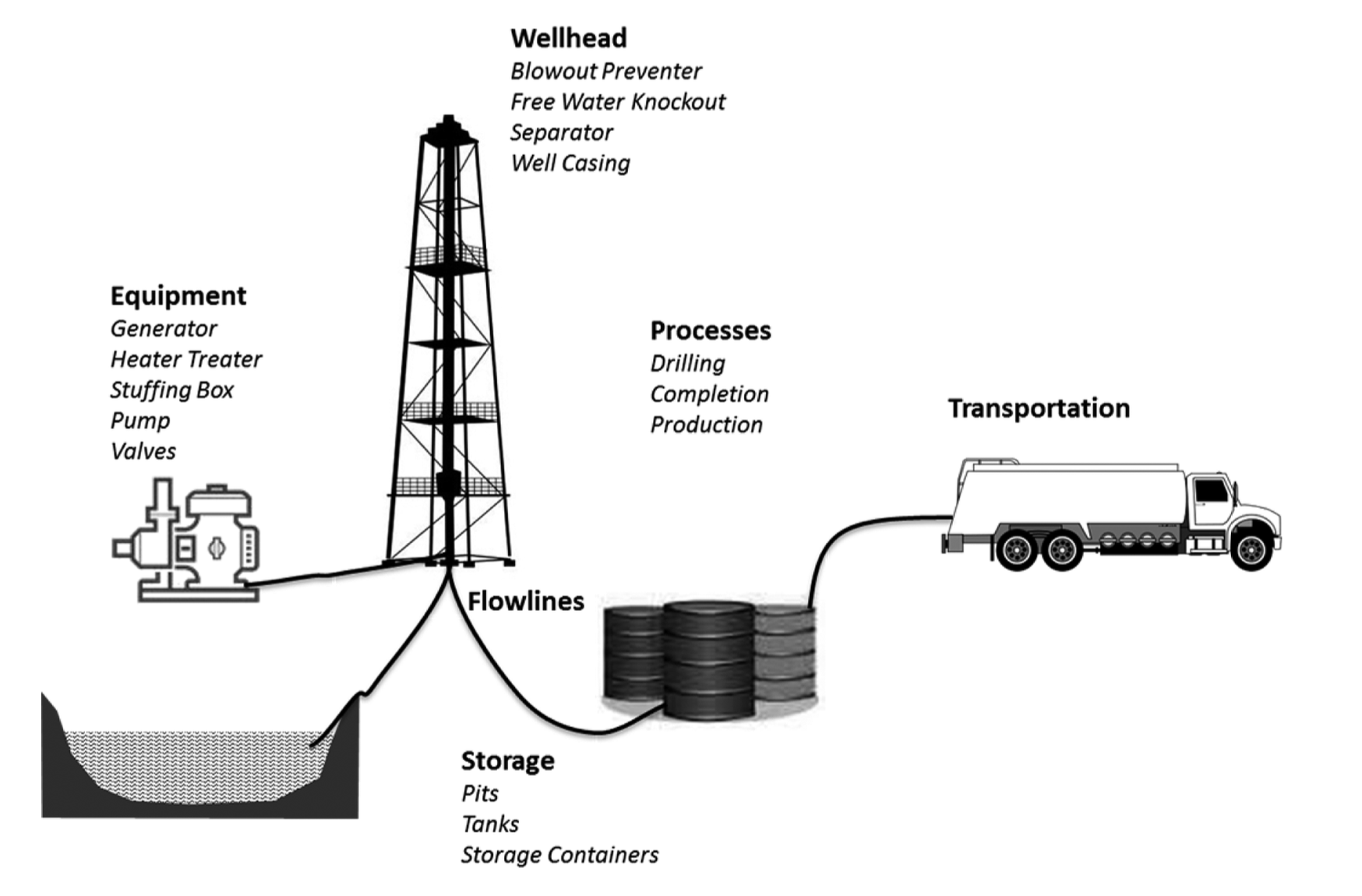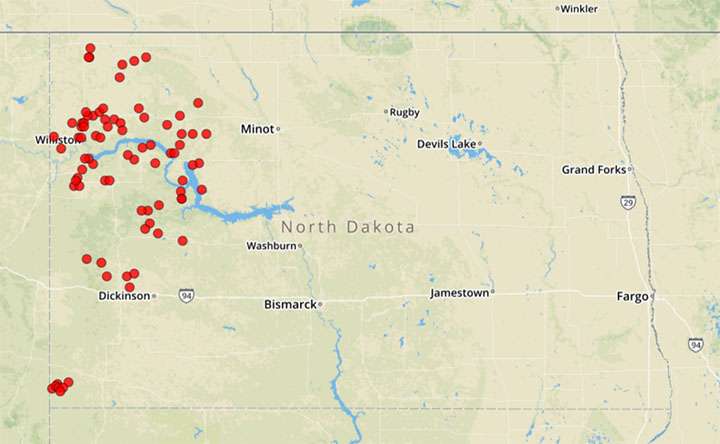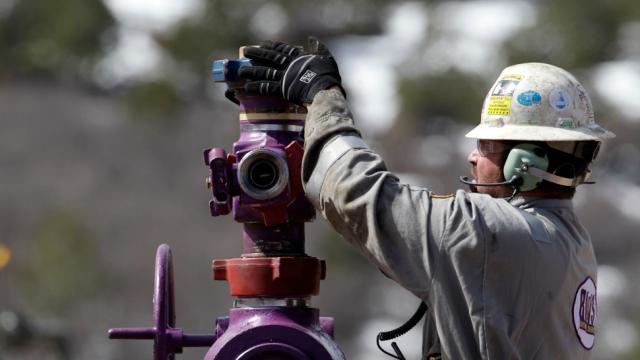An alarming new study has identified 6600 chemical spills related to hydraulic fracturing in just four US states over a 10 year period. The finding shows that fracking is far messier than previously assumed, and that stricter safety measures need to be established and enforced.
A worker switches well heads during a pause in the water pumping phase at the site of a hydraulic fracturing operation in Colorado. (Image: AP)
New research published in Environmental Science & Technology shows that upwards of 16 per cent of hydraulic fracturing, or “fracking”, wells in Colorado, New Mexico, North Dakota and Pennsylvania report a spill each year. These sites — whether it be due to human error, shoddy equipment or environmental factors — dump chemical-laden water, hydraulic fracturing fluids and other nasty substances onto the ground, where it can trickle into sensitive water sources. The new research, in addition to offering important insights into the frequency, volume and cause of spills, points to the need for standardising how spills are reported.
[referenced url=”https://gizmodo.com.au/2016/12/the-epa-finally-admitted-that-fracking-contaminates-drinking-water/” thumb=”https://i.kinja-img.com/gawker-media/image/upload/t_ku-large/n6fdnnx8b5s4eiiqjeal.jpg” title=”The EPA Finally Admits That Fracking Contaminates Drinking Water” excerpt=”A new report by the US Environmental Protection Agency concludes that hydraulic fracturing is capable of contaminating drinking water at virtually every stage in the process. The admission won’t sit well with President-elect Donald Trump, who has vowed to expand the controversial practice.”]
The Duke University researchers who conducted the study looked at spill data from 2005 to 2014, identifying 6648 individual spills at 31,481 fracking sites located in the four states. On average, that’s equivalent to 55 spills per 1000 wells in any given year. These numbers exceed the 457 spills calculated by the US Environmental Protection Agency for eight states between 2006 to 20012; the EPA only considered spills that happened during the initial hydraulic fracturing stage, neglecting other stages of the process, like transportation and storage.
Looking at each state individually, North Dakota recorded 4453 incidents during the period analysed, Pennsylvania recorded 1293 spills, Colorado 476 and New Mexico 426. Importantly, these are the spills that were actually reported; each state has its own requirements for what constitutes a spill, when an incident report needs to be filed and how a spill is described in the literature. For example, North Dakota defines a spill as 159L or more, but Colorado and New Mexico define it as needing to be 795L or more.
Aside from the quantity of chemicals spilled, the researchers also looked at the total area over which the chemicals were dumped. Volumes ranged from just 0.5m3 through to large spills exceeding 100m3.

Common pathways for spills. (Image: Lauren A. Patterson et al., 2017)
Revealingly, over 75 per cent of the spills at these sites occurred within the first three years of a well’s life, when drilling, hydraulic fracturing and the heaviest production is occurring. A significant portion of the spills happened at sites that had already experienced a spill, suggesting, not surprisingly, that certain sites are prone to systemic issues.
Across all four states, 50 per cent of spills were related to storage and moving fluids via pipelines. Causes included human error, equipment failure and environmental conditions. That said, it wasn’t always possible for the researchers to determine the exact cause of the spill, as some states simply require a narrative description of the accident (rather than ticking off formal categories).

A screengrab from the study’s interactive map shows a decade’s worth of spills of more than 18,927l of pollutants from pipeline leaks at North Dakota hydraulic fracturing sites. (Image: Science for Nature and People Partnership)
The researchers have produced an interactive map, allowing the public to see how spill frequency, volume and causes vary with the age of the well.
The reporting process, as this study makes painfully clear, needs to be revamped.
“Making state spill data more uniform and accessible could provide stakeholders with important information on where to target efforts for locating and preventing future spills,” said Lauren Patterson, policy associate at Duke University’s Nicholas Institute for Environmental Policy Solutions and the study’s lead author, in an interview with Gizmodo. She says that states would benefit from setting reporting requirements that generate actionable information — that is, information regulators and industry can use to identify and respond to risk hot spots — and standardising how spills are reported. “This would improve accuracy and make the data usable to understand spill risks,” she said.
In addition, standardising reporting and data collection would increase transparency and improve the ability of both the industry and regulators to do their jobs.
“For example, where data reveals that spills occur during the transport and transfer of materials, caused by human error, industry could target loading/unloading training for drivers,” Patterson told Gizmodo. “Or, if industry finds that a lot of valves are freezing in a particular location, and then failing when the temperatures rising, they could replace those valves with freeze-resistant valves. Meanwhile, regulators could calibrate inspection efforts to wells in the first three years of life, or wells that have already experienced a spill and to pieces of equipment most at risk for failing.”
The results of this study will be presented to US state regulators at an upcoming conference held by the Groundwater Protection Council. And as part of a two year collaborative project funded through the Science for Nature and People Partnership (SNAPP), hosted by the National Center for Ecological Analysis and Synthesis, the Duke University researchers are currently working on a paper looking at leading practices for for unconventional oil and gas extraction, namely hydraulic fracturing.
[referenced url=”https://gizmodo.com.au/2016/12/trumps-pick-to-lead-the-epa-is-suing-the-epa-over-climate-change/” thumb=”https://i.kinja-img.com/gawker-media/image/upload/t_ku-large/rsyqtentceszhk84axfd.jpg” title=”Trump’s Pick To Lead The EPA Is Suing The EPA Over Climate Change” excerpt=”If Donald Trump is trying to make good on his promise to dismantle the Environmental Protection Agency, he’s picked the right man to get the job done.”]
Sadly, these latest findings, along with the prescriptions, may fall on deaf ears. The Trump administration has made it clear that the United States is heading into an era of deregulation. With Oklahoma Attorney General Scott Pruitt now heading up the EPA, we can expect less oversight and regulation of the oil and gas industry, not more.
